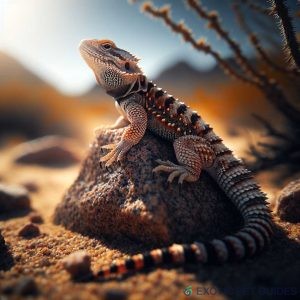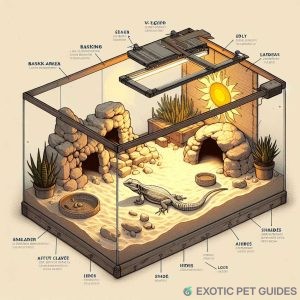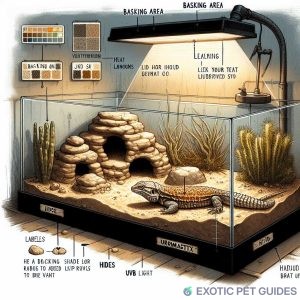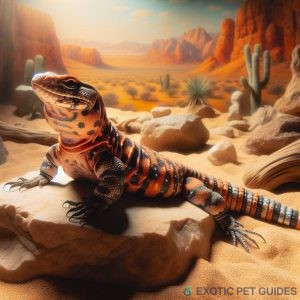🌵 Introduction
Looking for a unique, hardy, and insect-free reptile pet?
Meet the Uromastyx—also known as the Spiny-Tailed Lizard or “Desert Dragon”.
These vegetarian desert reptiles are:
- Easy to care for (once setup is correct)
- Long-lived (15–20+ years)
- Fascinating to observe
- Don’t need bugs (a huge win for many!)
In this beginner-friendly guide, you’ll learn everything you need to know to keep your Uromastyx happy and healthy.

📏 Tank Size & Enclosure Setup
Uromastyx are active diggers and baskers—they need space, heat, and light.
✅ Recommended Tank Size
| Age/Size | Minimum Enclosure |
|---|---|
| Baby (0–6 mo.) | 20–30 gallon (temporary) |
| Adult (up to 15″) | 40–75 gallon long tank |
| Large species | 4ft x 2ft x 2ft minimum |
🧠 Tip: Floor space matters more than height. They are terrestrial.
🧱 Essential Tank Features
- Front-opening glass or PVC enclosure
- Solid lid to retain heat
- At least 2 hides (hot side + cool side)
- Flat basking rocks

🌡️ Temperature & Heating
Uromastyx need very high heat to digest food and stay healthy.
🔥 Temperature Gradient
| Zone | Ideal Temperature |
|---|---|
| Basking spot | 110–130°F (43–54°C) |
| Cool side | 85–90°F (29–32°C) |
| Nighttime | 70–75°F (21–24°C) |
✅ Use a basking bulb + ceramic heat emitter. Never rely on under-tank heat alone.

💡 Lighting & UVB
These desert dwellers need strong UVB exposure to process calcium and avoid metabolic bone disease (MBD).
- Use a T5 HO UVB tube (e.g., Arcadia 12% or Zoo Med 10.0)
- UVB bulb should stretch at least 2/3 of the tank length
- Replace UVB bulb every 6–12 months
💡 No UVB = future health problems. Always install one!
🥬 Diet: 100% Vegetarian
Uromastyx are strict herbivores—never feed insects or meat.
✅ Daily Diet Can Include:
- Leafy greens (collard, mustard, turnip, dandelion)
- Squash, carrots, cactus pads
- Lentils (dry) or bird seed as treats
- Occasional flowers (hibiscus, nasturtium)
❌ Avoid:
- Lettuce (low nutrition)
- Spinach, kale (oxalates bind calcium)
- Fruits (too sugary)
- Animal protein (can cause gout & organ damage)

🧽 Substrate Options
Choose dry, naturalistic substrates for digging and hygiene.
Recommended:
- Excavator clay
- Loose sandy soil (not pure sand!)
- Tile + dig box combo
Avoid:
- Reptile carpet
- Calci-sand
- Wood shavings
🧼 Cleaning & Maintenance
| Task | Frequency |
|---|---|
| Spot clean poop | Daily |
| Water dish clean | Every 1–2 days |
| Substrate sift | Weekly |
| Deep clean tank | Monthly |
💡 Behavior & Lifespan
- Temperament: Shy at first, but tameable
- Activity: Diurnal (active in day)
- Defense: Tail-whip, burrow, hiss
- Lifespan: 15–20+ years with good care

✅ Pros & Cons Summary
| Pros | Cons |
|---|---|
| No insects or meat needed | Requires very high heat |
| Easy to tame | May be shy at first |
| Long-lived and hardy | Needs large tank setup |
| Visually stunning (bright colors) | Some species are harder to find |